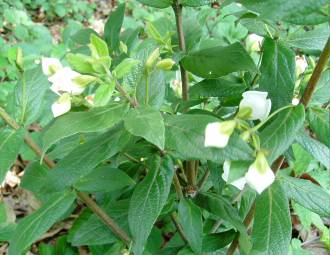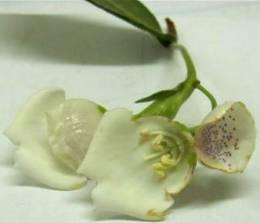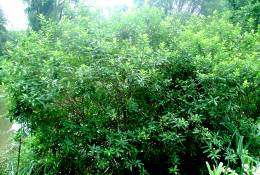Bowkeria verticillata
Bowkeria verticillata (Eckl. & Zeyh.) Schinz
Family: Stilbaceae
Common names: Southern Shell-flower, Natal Shell-flower Bush (Eng.); Suidelike Skulpblombos, Natalse Skulpblombos (Afr.); umBaba, isiPhambathi (Zulu); isiDuli, iGqabi-lesiduli (Xhosa)
Introduction
A decorative shrub that can be used to landscape your garden, with softy quilted leaves and pure white, scented flowers.

Description
Description
Bowkeria vercillata is a multi- or single-stemmed shrub about 3-5 m tall, occasionally a small tree. The stems are grey, branchlets are reddish and twigs with raised white dots. Oblong elliptical leaves are 25-130 x 6-65 mm, have entire or finely scalloped margins, sometimes hairy beneath and are borne in whorls of three to four. It is evergreen and the foliage makes a dense screen with a smell like other Bowkeria species.
The pure white, scented flowers (20 mm long), are sticky and glint in the sunshine, they are borne in pairs in the leaf axils, in early summer, from November to January. The inside of the flower shows a pattern of red marks which are probably a guide to the oil hairs for the pollinators. The fruit is a thinly woody, oval capsule (16 mm long) and splits into three valves during late summer (December to April). The fruits look as though they are made of polished cardboard and after having released the dust-like seed will remain on the plant for some time.

Conservation Status
Status
This species is assessed as Least Concern (LC) by the Red List of South African Plants. It is not threatened.
Distribution and habitat
Distribution description
Bowkeria verticillata is found on forest edges and particularly among thick evergreen scrub along small watercourses in KwaZulu-Natal and the Eastern Cape. It also grows well in full sun in gardens with temperate summers with a good rainfall; it is frost-tolerant but cannot withstand drought. Don't attempt to grow it at the coast as it dies off during the humid summer months.
Derivation of name and historical aspects
History
Bowkeria is a small genus with three species confined to the eastern regions of South Africa. It was named in 1859 in recognition of the contribution by the well-known naturalist, Col. Henry Bowker and his sister Elizabeth, to South African botany.
Ecology
Ecology
Bowkeria verticillata is pollinated by the oil-collecting bee Rediviva rufocincta. These bees use the specialized setae on the forelegs to collect oil from the oil-secreting hairs on the inner surface of the pouch of the flower. The oil is then transferred to the hind legs and carried to the nest where it becomes part of the larval food.
Uses
Use
There are no records of Bowkeria verticillata being used for traditional practices. It does have considerable value as a horticultural subject. The leaves are browsed.

Growing Bowkeria verticillata
Grow
Bowkeria verticillata is slow-growing; about 500 mm per year, and flowering begins after five years. It is pretty enough to be used as a single specimen or it mixes well in an informal screen. Good companion plants are Agapanthus and Crinum species.
Plant in full sun or semi-shade. The area should be composted and watered well in the first few years. It grows best in high rainfall summer areas and cannot survive drought. It will need supplementary watering in very dry periods. It is frost-hardy but will not do well in humid areas.
This species is particularly attractive while in flower because the dark green leaves contrast with the pure white, scented flowers.
Bowkeria verticillata can be propagated from seed or cuttings.
Collect fruit in autumn while still slightly green and keep in a paper bag to catch the fine seed, which can be stored in the fridge until the following spring. Seed germinates easily. Sow sparingly in a well-drained medium and place in a ventilated position to avoid fungal infection. Seedlings can be transplanted as soon as they are strong enough.
New green shoots or semi-hardwood cuttings, about 100 mm long, treated with rooting hormone, usually strike well in a mist bed.
References
- Coates Palgrave, M. 2002. Keith Coates Palgrave Trees of southern Africa, edn 3. Struik, Cape Town.
- Johnson, D., Johnson, S. & Nicholls, G. 2002. Gardening with indigenous shrubs. Struik, Cape Town.
- Nichols, G. 2005. Growing rare plants. A practical handbook on propagating the threatened plants of southern Africa. Southern African Botanical Diversity Network Report No. 36. SABONET, Pretoria.
- Pooley, E. 1993. The complete field guide to trees of Natal, Zululand & Transkei. Natal Flora Publications Trust, Durban.
- Raimondo, D., Von Staden, L., Foden, W., Victor, J.E., Helme, N.A., Turner, R.C., Kamundi, D.A. & Manyama, P.A. (eds) 2009. Red List of South African plants. Strelitzia 25. South African National Biodiversity Institute, Pretoria.
- Scott-Shaw, C.R. 1999. Rare and hreatened plants of KwaZulu-Natal and neighbouring regions. KwaZulu-Natal Conservation Service, Pietermaritzburg.
- Steiner, K.E. &Whitehead, V.B.1991. Oil flowers and oil bees: further evidence for pollinator adaptation. Evolution 45: 1493-1501.
Credits
Lufuno Konanani
Kwazulu-Natal National Botanical Garden
December 2010
Plant Attributes:
Plant Type: Shrub, Tree
SA Distribution: Eastern Cape, Free State, KwaZulu-Natal
Soil type: Sandy, Loam
Flowering season: Early Summer
PH: Acid, Neutral
Flower colour: White
Aspect: Full Sun, Morning Sun (Semi Shade), Afternoon Sun (Semi Shade)
Gardening skill: Average
Special Features:
Horticultural zones










Rate this article
Article well written and informative
Rate this plant
Is this an interesting plant?
Login to add your Comment
Back to topNot registered yet? Click here to register.